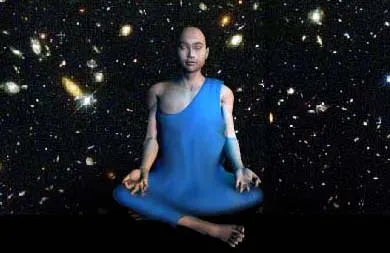Lucid Dreaming
History of Lucid Dreaming There is a state of consciousness in which any human being could
experience anything imaginable. Each of us holds within us infinite possibilities.
How many of us ever have the opportunity to taste even a hint of them? If we speak of our fantasies of wider vistas of life, we talk of our "dreams." Lucid Dreaming is not a modern discovery. Even though it has only come to the attention of the general public in the last few decades, even as early as the fifth century people were having lucid dreams. In fact, it is in the fifth century that we have the earliest written evidence of a lucid dream - in a letter written by St. Augustine in 415 A.D.
And even as early as the eighth century, the tibetan buddhists were
practising a form of yoga The dream yogis retreated more and more deeply into themselves until they started to dream, and they did so without ever losing conscious awareness. According to the Tibetan Book of the Dead, the yogis had almost total control over broad aspects of these "waking dreams." In the latter part of the twentieth century, the exact methodology of the the dream yogis remains obscure, but the concept used by them seems to be at the level of our most scientific and psychological findings. In many ways, the dream masters seem to have gone beyond anything known to us today. They seemed to have complete control over their dream worlds, and everything in them, and could conjure up endless Edens, explore alternate realities, and come to terms with such issues as the nature of reality and the meaning of life. At about the same time in India, similiar practises were being carried out. There are various tantric texts that describe methods of retaining consciousness while falling asleep, though it is to obscurely described to be of any use to the uninitiated today. There were various other references to lucid dreaming in history in the next few decades, including one in the twelfth century by the spanish sufi, Ibn El-Arabi, and another a century after that, where St. Thomas Aquinas mentions the subject briefly. Neither of them were that detailed though, and the next significant mention comes in the 1800's. In the nineteenth century, dreams were no longer seen as deriving from the underworld of the dead or the work of the gods. People now accepted that dreams took place in the unconscious underworld of the human mind, and this set the scene for scientific research into lucid dreams to begin. A significant figure in lucid dreaming history is the Marquis d'Hervey de Saint-Denys. He was one of the greatest nineteenth century pioneers of lucid dreaming, an industrious and dedicated experimenter who recorded his dreams from the age of thirteen years old.
In 1867, he first published his book Dreams and how to Guide Them, in which he documented more than twenty years of his own research into dreams. In the book, the Marquis describes the sequential development of his ability to control his dreams, first increasing his dream recall, then becoming aware that he was dreaming. Lastly, he tells us how he became able to awaken from his dreams at will. The Marquis d'Hervey de Saint-Denys was probably the first person to demonstrate that it is possible for anyone to learn to dream consciously. Then in 1900 one of the most well known figures in the history of psychology,
Sigmund Freud, Next came the man to who we owe the term "lucid dreaming", a dutch psychiatrist and dream researcher by the name of Frederik Willems Van Eeden. He coined the term "lucid dreams" to those dreams where the dreamer knows that they are dreaming. Though he was interested in all aspects of dreaming, he found that these lucid dreams aroused his keenest interest. At first he presented his ideas in a fictional book entitled The Bride of Dreams, because the fictional guise allowed him to freely deal with delicate matters. Then, in 1913, he presented a paper on lucid dreams to the Society for Psychical Research reporting on 352 of his lucid dreams collected between 1898 and 1912.
In the paper, he describes the 8 classifications of dream, including wrong waking-ups (more commonly known today as false awakenings) and demon-dreams. It is in this work that he first uses the term "lucid" to describe those dreams where the dreamer is conscious of them happening. Although many of his conclusions contradict the findings of modern researchers, the paper remains a classic. Several others did research into lucid dreaming in the early-mid twentieth century, as can be read in Lucid Dreaming by Stephen LaBerge, Ph.D. Moving onto the modern scientific studies of sleep and dreaming, one of the significant figures in modern lucid dreaming research, Professor Stephen LaBerge. The technological advances made in the past few decades have been phenomenal, and our knowledge of how the mind and body work has been increased as a result. The invention of a machine that could amplify and record electircal activity in the brain was a great breakthrough in science, especially for aiding research into sleep and dreaming. Up until the 1950's, scientists regarded sleep as a passive withdrawal from the world, a state of physical rest. But in 1952, intensive research into sleep and dreaming began. It did not take long to realise that sleep was not a uniform state as people suspected, but was classified into stages, each having different physiological markers. It was then recognised that when people were woken up from the active, or REM (rapid eye movement) stage of sleep, they nearly always remembered what they were dreaming about. When they were woken from the other 4 stages of sleep (collectively known as NREM, or non-rapid eye movement sleep) they rarely reported dreaming. Although this discovery was a great breakthrough, questions still remained unanswered, such as "How long do dreams last for ?" and "Does everyone dream ?". The answers to these questions were yet to come. This early psychophysiological dream research was important in the investigation of lucid dreams, but it only prepared the ground for what was to come. Celia Green, a parapsychologist, published a book entitled Lucid Dreams in 1968, which was based mainly upon the work of those I mentioned earlier, as well as information she herself had collected on the subject. But because parapsychologists were interested in the subject, psychologists dismissed it as a subject worth investigating, saying that to be consicous in your dreams is a contradiction in terms. Then in 1974, Patricia Garfield published a book entitled Lucid Dreaming which is still today regarded as one of the best general works on dreaming and lucid dreaming around. And it was this book that inspired Stephen LaBerge to approach the subject of lucid dreaming, and study it in a way no-one ever had before - scientifically. But the path to scientific lucid dreaming study was not always a steady one. In September of 1977, Stephen LaBerge applied to Stanford University, wanting to study lucid dreaming as part of a Ph.D program in psychophysiology. This was approved, and so he started his work on lucid dreams. Quickly gaining access to the Stanford sleep lab, he began his research into lucid dreaming with the help of Dr. Lynn Nagel, a researcher who shared the same keen interest in lucid dreams as LaBerge did.
Here is just one scenario, let's say you're afraid of heights and would like to learn to overcome it. You make a tape saying, "Relax - It's me we are dreaming, just relax we're perfectly safe, now let's work on our fear of heights, find a high place... Let's have some fun!" The above scenario would work on most fears such as - public speaking, fear of the opposite sex (develop confidence), any phobia... you get the idea. The mind can not differentiate between what is real or imagined. This is an ideal way to create who you want to be and what you want to experience in a perfectly safe world of your creation under your control. What you learn and experience while dreaming will have an effect on your waking life. What a painless and fun way to create personal growth for yourself...yes for yourself - you know the one you ignore the most? It's the same way you sculpt your body by doing certain exercises to look the way you want to, now you have the tool to sculpt your Personality, your outlook on the world around you! Or just have fun in your virtual playground. Your going to be there every night anyway, why not plan a virtual vacation? we spend 30% of our lives sleeping and dreaming? Now we can put that time to good use. While awake our lives are pretty much the sum total of our habits and programming. This programming happens to us all the time via TV, Radio, Newspapers and especially from those close to us - friends and family. Even though they are well meaning some of their fears are programmed into us which cause limit and lack in our lives. If you want more in your life you need to become more by changing the way you look at things, attitudes that in the past have held you back. Now, as most of us know it's hard to have the determination and willpower to change our habits even though we really want to. In HIGH level lucids your brain is far more switched on and connected, you have full memory recall and you feel bright and in control. You
are fascinated with what you see and can notice far more detail in
large complex scenes than you might have done in a low lucid dream.
Everything feels far more real than it did in the slightly mentally
dulled low level state in fact it may feel more real than normal
consciousness. This more real sensation is can only be paralleled
in waking life by peak moments such as adrenaline fueled experiences,
a car crash, falling or I imagine jumping from a plane. Its that
sharpening of the senses, that feeling of being very alive, you might
also get this from fearful situations in life, or extreme happiness. you have full memory recall and you feel bright and in control. You
are fascinated with what you see and can notice far more detail in
large complex scenes than you might have done in a low lucid dream.
Everything feels far more real than it did in the slightly mentally
dulled low level state in fact it may feel more real than normal
consciousness. This more real sensation is can only be paralleled
in waking life by peak moments such as adrenaline fueled experiences,
a car crash, falling or I imagine jumping from a plane. Its that
sharpening of the senses, that feeling of being very alive, you might
also get this from fearful situations in life, or extreme happiness.
The reason it is so hard is because there is a momentum or inertia in the way you have been doing things. In order to change that it will take an extraordinary amount of focusing in the desired direction to cause a change. Most of us are tapped out at the end of the day and don't have the personal power it takes to cause permanent and lasting change. This is where subliminal tapes, light/sound machines, and meditation come in. What is needed is a re-education of our subconscious mind. What better time or place to do that than in your dreams. |
 designed to maintain full waking consciousness while in the dream state. These
ancient dream
yogis possessed an unequivocal understanding of dreams, which is equal to,
if not more
advanced, than the knowledge we now possess today.
designed to maintain full waking consciousness while in the dream state. These
ancient dream
yogis possessed an unequivocal understanding of dreams, which is equal to,
if not more
advanced, than the knowledge we now possess today.  published the now renowned Interpretation of Dreams. Surprising as it may seem,
Freud did
not even mention lucid dreaming at all, but several years later he did add
a paragraph about
people who claimed they could be conscious during their dreams, and decide
upon the outcome
of their dreams in some cases. In 1914, he also added a small note based on
the work of the
Marquis d'Hervey de Saint-Denys, saying that "claimed to have accelerated
the course of his
dreams just as he pleased, and could give them any direction he chose."
published the now renowned Interpretation of Dreams. Surprising as it may seem,
Freud did
not even mention lucid dreaming at all, but several years later he did add
a paragraph about
people who claimed they could be conscious during their dreams, and decide
upon the outcome
of their dreams in some cases. In 1914, he also added a small note based on
the work of the
Marquis d'Hervey de Saint-Denys, saying that "claimed to have accelerated
the course of his
dreams just as he pleased, and could give them any direction he chose."